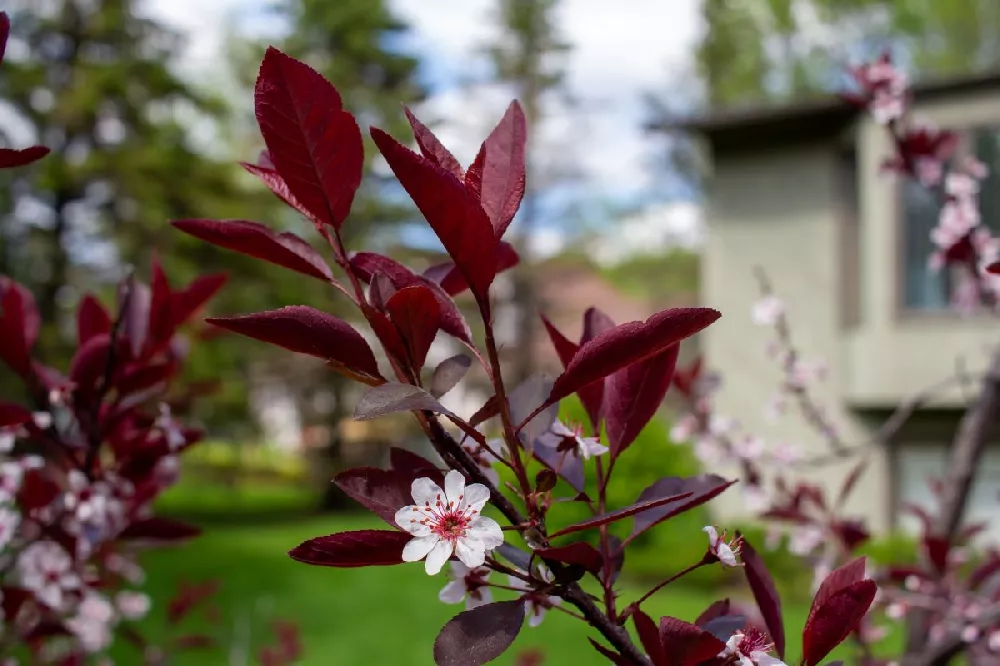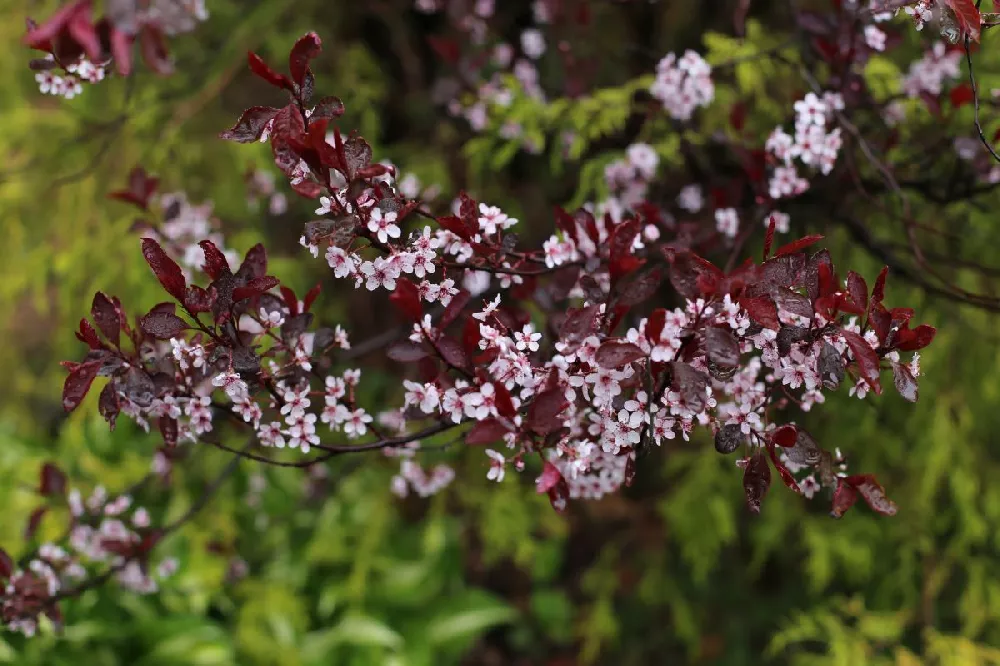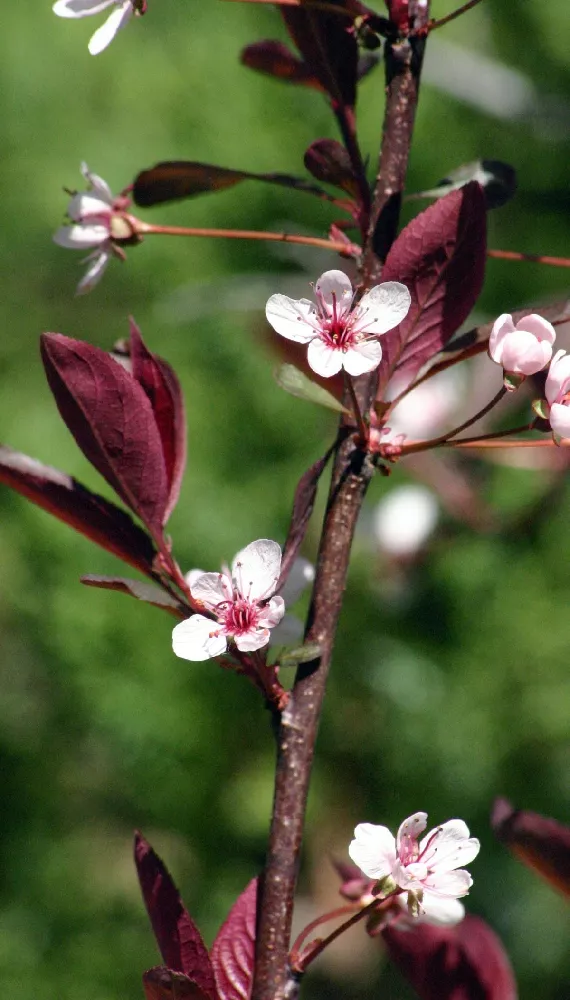- Home >
- Shrubs and Bushes >
- Purpleleaf Sand Cherry Shrub
Purpleleaf Sand Cherry Shrub for Sale - Buying & Growing Guide
The purpleleaf sand cherry shrub, Prunus × cistena,is a great choice for any gardener looking to add unusual color and texture to the garden. This appealing, mid-sized shrub features unusual purple burgundy leaves throughout the summer, which then change to a more bronze tone in fall before dropping. If that's not enough, in late spring the bush is covered in white-pink blossoms that are an arresting contrast to the darker leaves. You end up with three full seasons of unusual color, making this shrub an excellent focal point or specimen plant. The purpleleaf sand cherry is hardy throughout most of the continental U.S. and requires little extra care. Here are a few more reasons to add one to your garden today:
- In late summer, the shrub's small berries are magnets for songbirds and other wildlife.
- It tolerates most soil types, from clay to sand.
- It is tolerant of urban pollution, and it thrives even when planted near roadways.
Enter your zip code to find nearby stores that may carry this plant.
Plant Care
Sunlight

The purpleleaf sand cherry thrives in full sun — at least six to eight hours of direct light a day.
Watering
This shrub is not drought-tolerant and does best with an inch of water each week. Water it more in dry or hot weather.
Fertilizing

Fertilize in spring with a general-purpose, slow-release fertilizer designed for landscape trees and shrubs.
Planting and Care
Planting instructions
Site your purpleleaf sand cherry where it will get at least six hours of direct sunlight a day, in soil that is rich in organic material and drains well. Unpot the shrub and tease out any encircling roots, which can girdle the tree and slowly kill it. Dig a hole that’s as deep as the root ball and twice as wide. Place the shrub in the hole, spreading out the roots. Holding the shrub upright and steady, fill in around the roots with topsoil that’s been mixed with well-rotted compost or manure, tamping down as you go to eliminate air pockets. Water thoroughly. Apply a 2- to 3-inch layer of an organic mulch, such as bark chips, to conserve moisture and hinder weed growth, but keep it from touching the trunk, which can encourage rot.
Watering and nutrients
The purpleleaf sand cherry is not drought-tolerant and appreciates soil that is consistently moist but not waterlogged. Watering once a week, giving it about an inch of water each time, should be sufficient. However, if your weather is very hot or dry, increase your watering schedule. Fertilize your shrub with a slow-release, balanced product that is designed for landscape trees and shrubs.
Pollination
The purpleleaf sand cherry is beloved by pollinators such as bees and wasps, which are drawn to the fragrant white-pink flowers in spring. When pollinated, the flowers lead to small cherry-type fruit which contains the seed. Since the purpleleaf sand cherry is a hybrid, however, the seed will not grow true to type if planted.
Pruning
Monitor your purpleleaf sand cherry for dead, diseased, or damaged branches, and trim these out whenever you see them. In early spring, before new growth appears, do some maintenance pruning by cutting away about a third of each branch to encourage vigorous growth and abundant flowering.
Pests, diseases, and animals
Pests that may prey on your purpleleaf sand cherry include Japanese beetles, borers, and aphids. An organic insecticide may be useful, or you may consider releasing predatory insects, such as lacewings and ladybugs, which feed on these pests. Diseases include powdery mildew, fire blight, and leaf spot. These are all fungal in nature. To help avoid them, water at the base of the trunk, without wetting the leaves, and keep the area around the root zone free of leaf debris or litter. Small mammals, such as squirrels and chipmunks, may be attracted to your tree when it is fruiting, but they should not cause any problems unless you plan on harvesting the fruit
Achieving maximum results
One way to achieve maximum results is to consider carefully how you will use this attractive shrub in your garden. It can be grown as a single-trunked tree by pruning out all secondary trunks, and when this is done, it makes an excellent specimen tree for a front yard or near your home. If left to grow naturally, it will assume a multi-trunk bush form. Consider using multiples to form an informal hedge by a patio or walkway, or place it in front of taller bushes or trees to offer colorful contrast to the green leaves. Since it is not a very large plant, maxing out ata height of 6 to 10 feet, it is also a good choice for urban gardeners working in more petite landscapes.
FAQs
Is the fruit of the purpleleaf sand cherry edible?
Where can I grow a purpleleaf sand cherry?
These shrubs grow best in USDA hardiness zones 3 through 8. That means they are hardy in almost all of the continental U.S., except for the most tropical southern portions of Florida, Texas, and a few other states.
How long does a purpleleaf sand cherry live?
These are not long-lived shrubs, and they may only last for 10 to 15 years becausethey are susceptible to several pests and diseases. You may, however, get many more years out of your shrub by planting it in a spot with good soil and adequate sunlight and by taking good care of it throughout the year.
You can't add more Product Name - Product size to the cart.
OK



